Catherine Astolfo's Blog, page 19
April 14, 2012
My Guest Blogger today is Eileen Schuh and her book is FR...
[image error]
My Guest Blogger today is Eileen Schuh and her book is FREE April 14, 15, and 16! Read on.
Let’s hear it for the eyes....
I love the new cover for THE TRAZ! I believe it is the girl’s eyes that draw one into the picture.
In the story, Katrina’s icy, clear, brilliant, deep blue eyes are mentioned often. In fact, everyone’s eyes are mentioned—Shrug’s slate grey eyes, Chad’s liquid dark eyes, Stack’s black eyes. Eye contact and body language play a large part in THE TRAZ—highly reflective of what happens during street-level communication. [image error] Clever members of criminal gangs seldom say what they really mean—motives are concealed, business is conducted in coded language, and exotic words and phrases known only to members bind the gang together. Those who possess secrets, knowledge, and information are those who become powerful.
To survive in a gang one must at the very least be able to interpret emotions expressed in basic body language. To advance in a gang, to attain a position of power, one must be able to both conceal one’s emotions and thoughts and see through the facades of others.
Katrina, as young as she is, is fairly adept at reading body language and rapidly hones that skill as she struggles to stay safe amidst the danger.
Learning to read others is a life-enhancing skill for all of us. Being able to tell if someone is joking or serious, sad or angry, focused or distracted is vital in both personal and work place relationships.Not until we leave behind the self-centred thinking of childhood does our awareness of others become keen enough to read body language. THE TRAZ may be a teen reader’s first exposure to the concept that much can be said without the use of words.
It’s my hope that by the end of the book, my young readers will have lost a bit of the egocentricity of childhood and begun to develop the socially important ability to both ‘speak’ and understand body language. _____________________________THE TRAZ eBook is free on Amazon Kindle for THREE DAYS ONLY-- April 14, 15 and 16. Don’t have a Kindle? No problem—you can easily download Amazon’s free KINDLE FOR PCs software to read eBooks on your computer.
THE TRAZ is available in paperback and ebook formats and in a special School Edition that includes a Teaching Guide. Click on the following links to purchase or sample THE TRAZAmazon eBookAmazon PaperbackSchool Edition PaperbackSchool Edition eBook
Also available from other fine online bookstores.If THE TRAZ is not on your local bookstore or library shelves, ask for it to be ordered in for you.
“LEAVE A COMMENT, WIN A KINDLE” Virtual Book Tour. Follow me through cyberspace as I promote THE TRAZ on blogs around the world. Each time you leave a comment beneath my guest blogs, I’ll enter your name in my draw for a Kindle. For more details visit my Facebook Fan Appreciation Page or follow me on Twitter.
Eileen Schuh is also the author of the adult Sci-Fi novella SCHRÖDINGER’S CAT
For more information on Schuh and her books visit her at:http://www.eileenschuh.comhttp://eileenschuh.blogspot.comFollow Katrina on Twitter: KatrinaBuckhold
Let’s hear it for the eyes....
I love the new cover for THE TRAZ! I believe it is the girl’s eyes that draw one into the picture.
In the story, Katrina’s icy, clear, brilliant, deep blue eyes are mentioned often. In fact, everyone’s eyes are mentioned—Shrug’s slate grey eyes, Chad’s liquid dark eyes, Stack’s black eyes. Eye contact and body language play a large part in THE TRAZ—highly reflective of what happens during street-level communication. [image error] Clever members of criminal gangs seldom say what they really mean—motives are concealed, business is conducted in coded language, and exotic words and phrases known only to members bind the gang together. Those who possess secrets, knowledge, and information are those who become powerful.
To survive in a gang one must at the very least be able to interpret emotions expressed in basic body language. To advance in a gang, to attain a position of power, one must be able to both conceal one’s emotions and thoughts and see through the facades of others.
Katrina, as young as she is, is fairly adept at reading body language and rapidly hones that skill as she struggles to stay safe amidst the danger.
Learning to read others is a life-enhancing skill for all of us. Being able to tell if someone is joking or serious, sad or angry, focused or distracted is vital in both personal and work place relationships.Not until we leave behind the self-centred thinking of childhood does our awareness of others become keen enough to read body language. THE TRAZ may be a teen reader’s first exposure to the concept that much can be said without the use of words.
It’s my hope that by the end of the book, my young readers will have lost a bit of the egocentricity of childhood and begun to develop the socially important ability to both ‘speak’ and understand body language. _____________________________THE TRAZ eBook is free on Amazon Kindle for THREE DAYS ONLY-- April 14, 15 and 16. Don’t have a Kindle? No problem—you can easily download Amazon’s free KINDLE FOR PCs software to read eBooks on your computer.
THE TRAZ is available in paperback and ebook formats and in a special School Edition that includes a Teaching Guide. Click on the following links to purchase or sample THE TRAZAmazon eBookAmazon PaperbackSchool Edition PaperbackSchool Edition eBook
Also available from other fine online bookstores.If THE TRAZ is not on your local bookstore or library shelves, ask for it to be ordered in for you.
“LEAVE A COMMENT, WIN A KINDLE” Virtual Book Tour. Follow me through cyberspace as I promote THE TRAZ on blogs around the world. Each time you leave a comment beneath my guest blogs, I’ll enter your name in my draw for a Kindle. For more details visit my Facebook Fan Appreciation Page or follow me on Twitter.
Eileen Schuh is also the author of the adult Sci-Fi novella SCHRÖDINGER’S CAT
For more information on Schuh and her books visit her at:http://www.eileenschuh.comhttp://eileenschuh.blogspot.comFollow Katrina on Twitter: KatrinaBuckhold
Published on April 14, 2012 07:48
April 7, 2012
Workin' Hard
This afternoon, I am writing. I have to do an article forour magazine, so I make a blank document and give it a name. I decide to dosome tweets. Next I fill out the tax forms for our business. Now, the writing. Suddenly two morning doves alight on the windowsill outsidemy office. I have no idea why morning doves are up in the p.m., but here theyare. One is a bit larger, with lovely blue markings; the other is small andmostly soft brown. I think the bigger one must be the male, because now andthen he jumps on top of the other one. Plus he's got the plumage. All maleshave plumage because they need to attract us females into their nests. Anyway, I'm still admiring my visitors when our smallest catcomes up to the shelf inside (which my husband built so they could look out thewindow…) and she sees the doves. They can't see her, however. They continue toruffle their feathers, coo; the female moves back and forth to escape herboisterous mate. Our cat begins to race, left to right, across the shelf,tracking the birds as they play. She can't get at them; they can't see her; noharm done. For some reason, this reminds me of my writing. I'm supposedto be writing. What a lovely scene to write about. However, I do have that article tofinish and I have begun the finishes touches on novel five. Then there's thatcozy and the children's book. Speaking of book five, I think about the Emily Taylor seriesand how my lovely publisher has suggested connecting it to Burchill. I'dclaimed Book 4 was the last in the series, but Cheryl Tardif of Imajin Books isa brilliant marketer, and she knows what's she talking about. After we spend somuch time branding the Emily Taylor Mystery series, why not keep it going? I sit and bask in the gratitude for a few minutes, as thesun shines through my spotty windows, right on my face, warm and spring shy. TheBridgeman has been selling all around the world. People in the US, UK andGermany have my book, as well as my own Canadians. I am in awe. A few shortmonths ago, I would never have believed this. I am excited, happy, challenged,thankful. Now Victim is going to spread her wings with a free promo, fly off toforeign lands, sit in homes hundreds of miles away from where I sit…doingnothing. Back to the writing. What did I call that article again? Iknow it's on the desktop somewhere. Meanwhile, the doves fly away and Miss Monk goes to sleeppurring. Suddenly, I have a great idea for how to connect Book 5 toBurchill. Where did I put that file? www.imajinbooks.com
Published on April 07, 2012 11:13
March 31, 2012
My Legacy
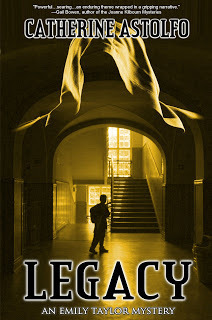
My Legacy
Lots of other authors have writtenthat they get asked, "Where do you get your ideas?" In my case, however, readers often add an expletive. Theymake queries such as, "Where the HELL do you get those ideas?" or "Why the F doyou write about stuff like that?" Sometimes they look at me, with my innocentround face, my middle-aged wrinkles, my guileless blue eyes—OK, maybe notinnocent or guileless, but I do resemble a mild-mannered older woman—and theyare aghast. They can't believe that I write aboutsordid crime, involving puppy mills and animal torture, murders by knife, gunand fire, neglect and abuse of children. They often think there must be somedeep dark secret, some childhood trauma of my own, that I am hiding. Somethingso horrible awful that I can only allow it into daylight through my writing.Perhaps I am a psychopath who's found a way to do my evil deeds withoutactually harming anyone, akin to a Dexter but without the knives.I do actually have a couple ofsecrets, but they're not really hidden. One: I am a retired school principal.I've seen, heard, and experienced the fall-out from pretty terrible crimes,most of them inflicted upon the innocent, human or not. The other secret isthat I read the newspaper as well as true crime books. There is nothing in mybooks that could possibly be worse than what actually happens in real life.The great part, though, is that Iget to punish the bad people in my novels. I send them to their maker ortorture them back or kill them outright or put them in prison. I exact revenge.In fact, I can claim that I am a social justice activist in my own weird way. Iright wrongs, ensure happy endings for most of the characters, and give theevildoers what they deserve. I am very much a product of the '50's whenSuperman or The Lone Ranger always stopped the destruction and mayhem.This all brings me to my currentebook, the third Emily Taylor Mystery, which is available starting April 1. It's a story of journeys. Severalvoices speak at once in the book, including Emily. The reader follows them allas they try to find answers to their personal dilemmas. And yes, it does havemy usual "dark" theme. The children in this book are victims, but they are alsoheroes, because in the end, goodness and hope do triumph. Each of the maincharacters experiences a dramatic transformation, an answer to their quest.Each of the villains is more than adequately punished. Justice, truth, andcommunity prevail. My Legacy. Order Legacy Here
Published on March 31, 2012 12:40
March 9, 2012
Emily Taylor Tours The World
The Amazon book ranks are like golf: the lower the score, the better you're doing. Sothe 48 hours during which my main protagonist Emily Taylor (via my first novel, The Bridgeman) went from 96,339 to 398was, to say the least, absolutely like getting a hole in one. (I've nevergotten a hole in one, mind you, so I'm just imagining.) I liked to envision Emily touring the world. I always had confidence in my writing. At school, atwork, I excelled with words because I have been obsessed with them sincechildhood. I took workshops, classes, and read tons of how-to books, attendedconferences, and went online to learn the craft and later, the business. I also wallpapered my bedroom with rejection slips. In frustration, I self-published the Emily Taylor mysteriesand sold about 300 copies of each of the first three to my family, friends, andcolleagues. The last one didn't sell because I was sick the year of its releaseand couldn't work at it. Despite the modest success and the wonderful compliments from ardent fans,there was still something missing. In 2011, I found my missing part: publisher Cheryl Tardif ofImajin Books. Not only did my publisher like my writing, she is also a masterwith marketing. Now I was beginning to get some confidence not simply withmy novels but also with my ability to find a wider readership. Until the end ofFebruary, however, I was dismayed at how slow the Emily Taylor Mysteries wereto catch on. My books are somewhat dark, not exactly classic mystery, and havea touchy subject at their core. But, dammit, they're really good and they'rethe kind of thinking book that I like to read!(That's what I say when I have a couple of glasses of wine and feel reallyself-assured.) What happened at the end of February? Cheryl Tardif, mypublisher, enrolled The Bridgeman in the Kindle Direct Publishing Selectprogram (KDP Select), which one writer (Joanna Penn) describes as the CanadianIdol for writers. (Although she said American.) If you have something to offeran audience, you need to let them know. It's a bit controversial, in that Amazon is attempting to push out allthe opposition with this program (shades of a monopoly). We were required to remove TheBridgeman from every other distribution channel. Then we offered it for freefor 48 hours. Here's what happened to The Bridgeman, almost minute by minute. At midnight on February 28, I started out with a rank of96,339 (remember, this is out of millions) on Amazon Kindle. Only 13 sales andno borrows. We now place it in the hands of KDP Select and give it out forfree. By 8 a.m., I am up at 2,131 rank for freebies, with 802 downloads, noborrows. Because of the sudden movement, though, I appear on two bestsellerlists: #17 in Kindle Mystery Women Sleuths and #50 in Kindle ThrillersSuspense. Guaranteed to stir more interest! Later that day – 1100 downloads in the U.S. alone. Cherylis encouraging: soon 1100 people will be reading The Bridgeman. They'll telltheir friends, and their friends will tell their friends… Here is where I start to envision Emily's tour around the world. Still later – 1157 US downloads + 61 in the U.K. My cousinin England is now reading my book! The rank: 134 on the free Kindles list. Thecoveted Top 100 Free Kindles is soooo close. By this time, I am biting my nails and jumping up and downin my seat. Not only that, I open a bottle of wine…will I celebrate or drown mysorrows? I tweet, facebook and google obsessively. Suddenly, Cheryl's messages begin to pop up regularly:"1241 US68 UK6 GermanyCongrats on breaking into the top 100 free kindles! Noteveryone makes that list so you did very well."And then…"2546 free d/ls in US and #87 Top 100 Free Kindle ebooks.This is excellent!""Over 4100 free d/ls now. Great first day, Cathy!!"At 10:25 pm: 4439...12:35 am: 5100...#29 Top 100 Free Kindle ebooksNext day: 7220 downloads By the end of the 48-hour freebies, at 11:15 PM: 9300downloads. Almost 10,000 people have my book in their hands! Emily is touringthe US, the UK, and Germany. But it doesn't stop there, and this is where it gets reallyinteresting. Here are Cheryl's messages one day later:"75 sales" – then "118 US sales so far, 27 Kindle Owner'sLending Library borrows" – then "You're averaging 100 US sales a day thismonth. You have 300 sales so far, and today isn't over yet" – then "You nowhave over 500 US sales. Congratulations, Cathy! This is very good! It's onlythe 4th (of March)—and early.Your rank is just under 400" (398 to be exact). By the 7th of March, I have over 700sales. I KNEW my audience was out there! And once they tuned in, Ithought they would like my characters, my setting, the puzzles I laid out forthem. Maybe even the social justice issues I wanted them to think about. Thetraffic has slowed a bit since then, but The Bridgeman is still selling more thanbefore. I am determined to keep this momentum going, at whatever speed. I might just leap on top of my roof and holler at the moonto spread the word. Until that sort of thing works, however, I'll follow mypublisher anywhere, including KDP Select, while I tweet, facebook, link,google....
Published on March 09, 2012 07:45
February 28, 2012
PROMO FEB 28/29
The Bridgeman is free today and tomorrow! Get your copy while it costs absolutely nothing and get hooked on the series. (I hope.) Click here! Even if you don't have an ereader or Kindle, Amazon will keep it in your virtual library until some day you can download it. The Bridgeman
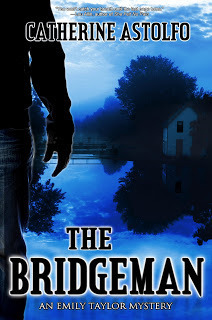


Published on February 28, 2012 13:52
February 25, 2012
Art and Bulls!
Feb. 23: The next morning dawns sunny and hot. We havebreakfast downstairs, where the ceiling is open up past the second floor.Someone is playing a flute outside and a cool breeze flows in. We tour thesquare around our hotel with José. The jardin has a beautiful fountain in themiddle, surrounded by trees of all kinds and bushes and flowers. People strollthrough it at all hours. The Ave Maria is a cathedral. Its wooden doors are enormousand ornate; it displays gold engravings everywhere, crystal chandeliers, andbeautifully tiled floors. Interestingly, all six of us agree that this ostentatiousgrandeur is sickening when we consider the fact that very poor peoplecontribute to it, even as they are starving and living in mud huts.
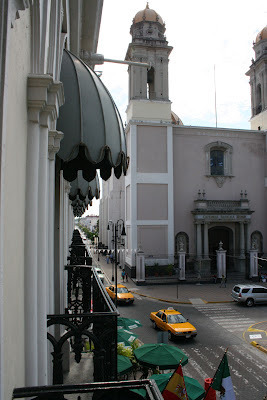
The church and its environs took twenty years to build,beginning in 1885. Underneath, we would find adobe brick, which has lasted allthis time. The plaster and painted façade, however, has been shaken andrefurbished a few times from earthquakes.
The convent next door is now agovernment building, the seat of the state governor. There's a huge opencourtyard in the centre, filled with palms and flowering bushes.
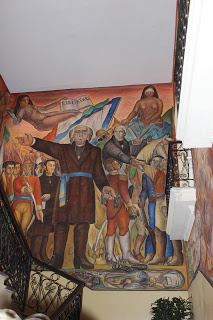
A painter,whose name is Correra I think), painted a beautiful mural up the wide marble staircasedepicting the history of the Mexican people. Justice and Liberty arerepresented by nubile women. He paints the Spanish conquerors as fierce lionswho come in and crush the eagle, since the eagle and the snake are Mexico'ssymbols. (The snake represents the lake upon which Mexico City was built.) TheAztecs fighting the Spanish is well drawn, depicting the terrors of war. An eleven-year revolution won Mexico's independence in 1810,but it wasn't until 1910 that the cruel hacienda system was overthrown. Thereis a big drawing of Emiliano Zapata in the mural. I instantly recognize him,since Marlon Brando played him in the movie. Vince remembers the story ofPancho Villa, who was Mexico's Robin Hood. A new constitution and the separation of church and state in1929 completed Mexico's transformation. José is rightfully proud of hiscountry. The next President might just be a woman, yay!
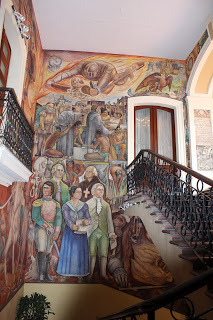
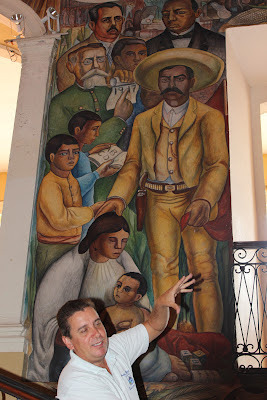 Emiliano Zapata aka Marlon Brando with José
Emiliano Zapata aka Marlon Brando with JoséFrom here, we drive to the Museum of Popular Art. It'sabsolutely fascinating. At the door, we're met by huge models of MagisterioTeresa Pomero and her husband. She was a founder of the museum and a reveredart teacher. Traditional masks and dress, huge multi-colored diadems, some witheagle feathers, some depicting good and some evil. Many revel in the concept ofdeath. José tells us that Mexicans celebrate death, since it is inevitable andsomething everyone will experience, they believe in removing the dreadsurrounding it. Their Aztec ancestors believed in reincarnation and preparedbodies for their travels in the next world with food and necessary articles. OnNovember 2 every year, they have a huge festival in celebration of death. Somepeople walk from Manzanillo to Mexico City, and do part of the pilgrimage ontheir knees. Mexicans still wear masks during festivals. There are tapestries with vivid colours and embroidery. Adragon is so exquisite that we gasp, but can't make out the material that it'sconstructed from; perhaps a thin ceramic. One headdress looks like an upsidedown lampshade. One model shows its entire body painted with symbols. Anotheris a man on a stick horse. One has a mermaid's tail. Tigers, jaguars, all kindsof masks with various looks and colors and decorations. The embroidery on theclothing is exquisite. We see traditional stringed instruments, drums,furniture (some of the Hidalgo style), toys, pottery, carvings, dolls, andminiatures. One miniature depicts the voladores de papantla, which we saw inPuerto Vallarta: people climb a pole and then unravel downwards in concentriccircles. Beautifully carved horses make me think of Leedalo. As we are nearing the exit, Vince spies some artists workingin an open courtyard, so we go out to see. Two people are working on papiermaché effigies. Two others, an older man and a younger, along with a woman whoseems to be in charge of the area, are doing pottery. To our surprise anddelight, the older man turns out to be the sculptor of the huge dancing dogsthat greet us on our entry into Colima! We get his picture and are able toshake his hand. Vince then hears some music coming from a basement, just afew steps down from the courtyard. We ask if we can go in, and the woman getspermission. There are four young men practicing their various instruments,three with different types of guitars (don't ask me what they are called) andone with a flute. They play us a beautiful traditional song. It's again one ofthose moments: just by chance, we are privileged to hear these talented people. Afterward, we check out of the hotel but are able to watchthe parade from our balconies and drink some lovely cold beer and margaritas.Some of the horses that will participate in the rodeo dance up the street.They'll head to Alvarez, gathering other riders as they go. Leading the entiregroup is Mo. Teresa and her hubby! Teachers are revered in Colima. We beat them in the van to Alvarez and park beside thebullring. It's constructed by about a couple of hundred people every year, allfamilies who "own" a section of the ring, everything done by hand, weaved,nailed, and posted. See the pictures to get the idea!
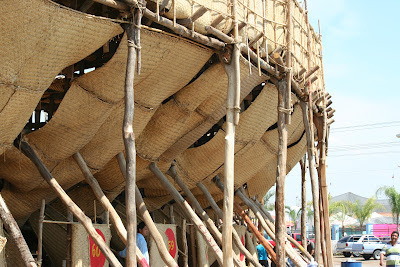
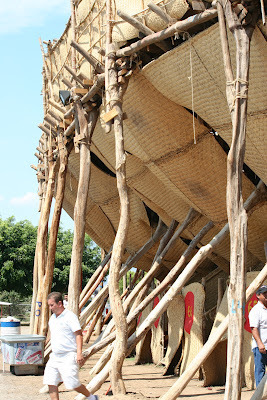
We "rent" our seats inSection 65. Soon the Pomeros arrive and behind them come the horses of therodeo: brown, silver, black, white, combinations of colors, every one of themgorgeous, sleek and strong. A man on a donkey comes up and mocks us gringoes (we're notsure what he's saying). Someone behind us growls at him. José says they areembarrassed by the rider's behavior, and stated that "you don't have to studyto be a clown". Everyone else seems pleased to see the gringos in their midst.The riders are young, old, and in between. The horses danceto the beat of the music, bow, circle, and move precisely as their owners dorope tricks. One man stands on his horse and loops the rope from his head tothe ground, in almost invisible circles.
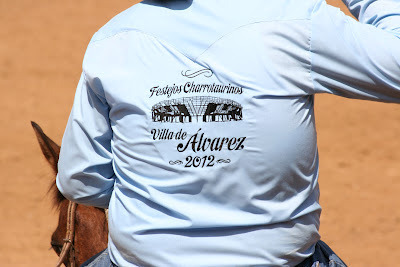
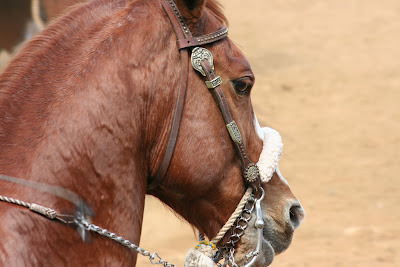
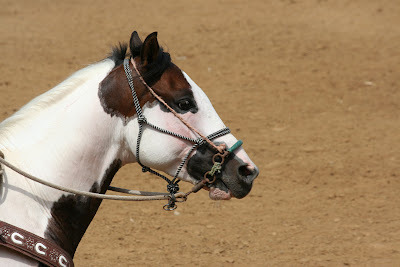
We drink cold cervesa, try watermelon with crushed peppers,and guavavilla. Maire, Rosaleen and I take a shot of tequila from the horn of abull. When the first bull comes into the circle, we are ready!The first bull is a hefty brown guy who shakes off his riderfairly quickly and immediately gets roped. He goes down in a cloud of dust, hishead and legs trussed. They untie him and he heads knowingly for the exit. Thesecond bull is feisty and we cheer for him. He shakes off his rider right awaythen does several mad runs around the ring before he is finally roped. Thethird bull heads to the exit at the beginning. This one is smart! He stops,trying to get the rider to slide off the front. He is coaxed back up, but therider gets off and the bull goes out the exit on his own. The fourth bull, awhite one, has some trouble getting his rider off, but finally does. Then heraces all around, kicking up dust, avoiding the ropes. Eventually, he goes downright in front of us, the dust in the air flowing over our heads.
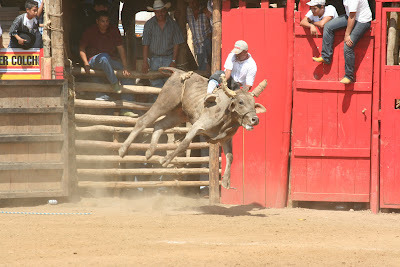
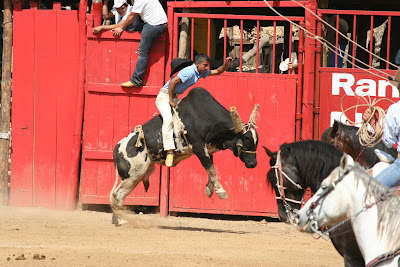 The first part of the rodeo is over. They will be off to a big lunch now and the bull fight will happen later - which we are not staying for. The horses dance for usas they exit. One rider comes up to talk. He lives in Fresno, California, andspeaks English well. We give him a beer and he shares a bit about his life. He"loves his damned old rodeo" and comes every year.
The first part of the rodeo is over. They will be off to a big lunch now and the bull fight will happen later - which we are not staying for. The horses dance for usas they exit. One rider comes up to talk. He lives in Fresno, California, andspeaks English well. We give him a beer and he shares a bit about his life. He"loves his damned old rodeo" and comes every year.
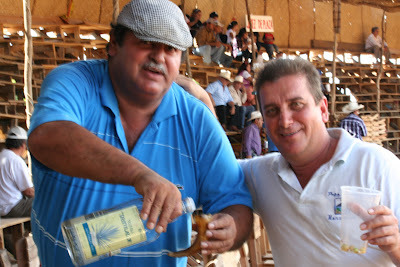 Jose´and our Tequila Man
Jose´and our Tequila Man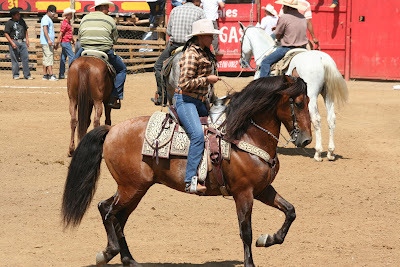
On the way out, we meet a family with a handicapped son. Hemust be studying English, because his mother points us out as "English" and hesmiles and shakes my hand. It's an encounter that's so indicative of thefriendliness of the Mexican people. I know that's a generalization, but sometimes you get afeeling from an area, or an atmosphere, and that's what we feel here.We leave Alvarez and have lunch in a beautiful open-airrestaurant near Colima. A mariachi band entertains us with lovely traditionalmusic while we feast on delicious meat and vegetables and beer and margaritas.When we're finished our meal, we sit and watch the dancers in gorgeouscostumes. Then out comes a fabulous singer, whose name is Flor Margarita (stagename?). She keeps us enthralled for a long time and afterward we buy her cd's.
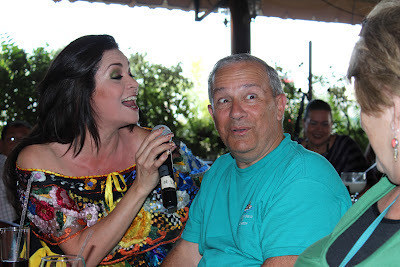
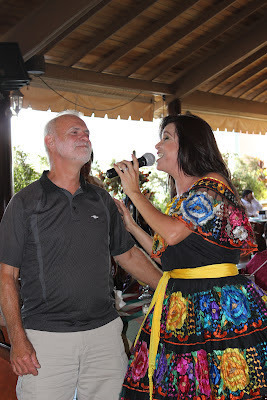
We're on the way home feeling thrilled and exhausted, but wewould do that trip all over again.
Published on February 25, 2012 09:21
February 24, 2012
Colima-Comala-Colima
Tues. Feb. 20: The next morning, we fly past palms andevergreens and various flowering trees as we traverse the Coastal Highway. Fora while, we can see the Pacific from the road, but after a while, we haveturned away from it. We are on our way to the city of Colima, which is thecapital of the state of Colima. We booked a two-day excursion from Pepé Tours, led by JoséGonzales. He picked us up promptly in a huge white van, which reminded us ofthe vehicle we called "the bread truck" when we were in France. Of course, noone much younger than our gang will remember the bread trucks of old. Just knowthat they are huge. He could fit 14 people in it and we are only five, plusJosé.
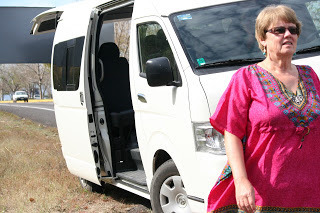
José is a slim, lively man with a great command of Englishand a wicked sense of humour. We took to him at once. As he drives, he talks about the natural gas pipeline thathas been coming into Manzanillo for at least as long as Maire and John havebeen staying here (five years). It's finally ready, simply awaiting thePresident of Mexico to open it on March 21 with a grand flourish andcelebration. The gas will come from the Gulf of Mexico and the line wasconstructed by a Canadian company. The pipeline means a lot to Manzanillo, from cleaner air tomore energy for more projects. There are tons of improvements an expansionsbeing made to the harbour, for instance, which is already the largest in NorthAmerica. I can still picture the development from the vantage point of themountain yesterday. We are driving along a new toll road, which curves aroundthe bay. Palms and evergreens and bushes are lush and partly flowering. Joséexplains that the winter months are kind of like our "autumn"; leaves fall andthe trees are comparatively bare of flowers. Some have begun already, though,such as the primavera. In April, our street in Las Brisas will be covered inred flowers from the "red flame" trees (also known as the Royal Poinciana).Black sand beaches glint in the sun, as we follow the chain of volcanoes thatstretch from Central America to northern Mexico, including Mexico City. Colimais the third largest state in the country. Its main crops are coconuts, limes,sugar, and sea salt. Many of the crops were ruined in the October hurricane,but they're well on their way to recovery now. Colima City is the statecapital, as well as home to the largest Corona plant, yay! Green waving stalks of sugar, flowering coffee bean plants,row upon row of lime and papaya trees decorate our view as we drive along. Afence around one farm of bushy limes is covered in bougainvillea: red, pink andwhite bouquets of color. We stop and look down upon a clay brick operation,family-owned, where the red shapes are formed by hand. A huge oven cooks theminto rounded half cylinders for rooftops. José says they get about half a pesoper brick, despite the hours of work that goes into them. We cross the ArmeriaRiver, peer down from the winding highway at lagoons and trees, tiny shackswith laundry hanging in the sun. Cows resting amid tall palm trees. Sugar cane,which is now harvested by machine, wave long hairy green arms. Cement is a bigindustry in this part of the state, with its soft limestone mountainsides.These are part of the Sierra Madres, gorgeous undulating mountains of green. Yaka is another popular fruit. We pass dozens of standsselling everything, all appearing succulent and delicious in the freshness ofthe day. As we get closer to Colima, watermelon and cantelope are also onoffer. We know how sweet these are from first hand experience. Agava plants dotthe roadsides – ahh, tequila! The primavera trees are beginning to flower, their blossomsa deep yellow or pink in the sunlight against an azure blue sky. Cacti strike astraight backed pose along the folds of the hillsides. Now we can see the twin volcanoes of Colima shimmering inthe distance. Here's a tourist guide's description from our favorite Internetsite (www.gomanzanillo.com): Driving north from Manzanillo, tourists willalways remember their first view of the majestic mountains of Colima. The inactive,snow-capped Nevado de Colima, towering above 14,200 feet and its activesmoke-and lava-spewing partner, Volcan de Colima, at more than 13,488 feetoverlook a lush, forested valley and tranquil lake. Lake Maria is formed byanother extinct volcanic crater, and is said to be 2,000 ft. deep. We stop andVince snaps some fantastic photos. One of them shows a cloud that resembles anenormous iguana. Ben's gila monster in cloud formation!
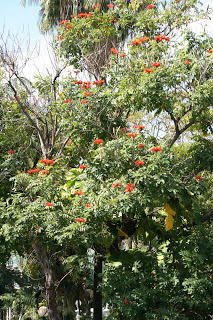
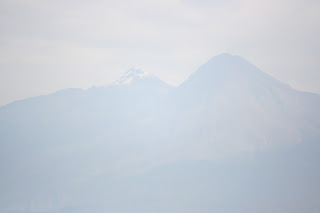 You have to look closely through the haze to see the twins!
You have to look closely through the haze to see the twins!Colima and its twin city of Alvarez hold nearly 250,000people. The natives were the Aztecs, the last chief being Coliman, thus thename of this beautiful place. Colimotes means "place of my grandfather". Theenormous sculpture of the hairless dancing dogs (Perros de Colima Bailarines)greets us at the outskirts. José says they herald good times and I am smittenwith the idea. The Shaman of the Aztecs would use them as symbols (andsacrifices) to ask the gods for joyful times. One of the dogs gives a "Tony"smile, just like my sister Chris's dog.
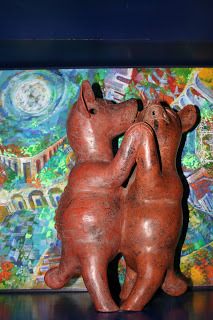
We stop in the square where the Ave Maria church, thegovernment building, stores and restaurants, plus our hotel, surround a lushJardin. The church is partially constructed of volcanic rock and topped withone enormous cupola and cross, and another smaller one. Our hotel is a Best Western,the Ceballos Hotel, once owned by a family of that name. Its ornate balconieslook out over the Jardin and the square. We check in, where we discover that wehave two rooms side by side, with a lovely sitting room in between. All alongare the Romeo and Juliet style balconies.
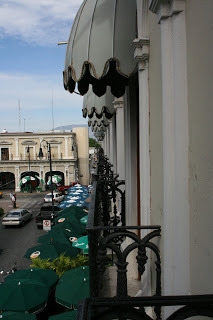
The parade of horses has been postponed to tomorrow, so wedecide to go to Comala today instead. As we head toward the smaller village, wepass an arena where cock fights still take place. People bet on the rooster oftheir choice. Once the bets are in, the doors are closed and no one can leaveuntil everyone declares they are satisfied with the outcome. It is a fight tothe death. I try not to picture the blood and feathers or to imagine the smellof such violence. The town of Comala is known as Pueblo Blanco, the whitecity, as it is renowned for everyhouse being covered in sparkling white paint. The streets are cobblestone,which makes for a very bumpy ride as we traverse the narrow roadways. We passcoffee plants, sporting white flowers, and here and there, a red bean signifiesit's ready to be picked. Old wooden doors or grayish plaster walls hide thelovely little courtyards within. José points out a door that harks from the 17thCentury. He says that no one really cares about the front of the houses; it'sthe courtyard and home that count. Comala is famous for a special coffee drink,which we hope to try. It's also lush with the parota, an exotic hardwood tree,which is used for furniture, doors, cabinets, and even ceilings. It's easilycarved and sanded into ornate decorations and shapes. We stop for lunch at Don Camalon. We've been here before, sowe know what to expect, but it's still an astonishing bounty. We are served atleast eight dishes before we say, "No mas". The food comes with the beer and isenough to make all six of us feel absolutely stuffed. José calls John acomelon, which means "good eater" because he is able to put away more than therest of us. Afterward we set off for Nogueras, the site of an art museum,Centro Cultural Nogueras-Museo "Alejandro Rangel Hidalgo". The buildings andgrounds used to be a hacienda, some parts of which are over 450 years old. Thechimney from the 17th Century sugar mill stands half crumbled abovethe rooftop of the old church and buildings. José points out the tamarinds andtells us the fruit from this tree makes a sweet sauce. Later, we find out thathe is absolutely right. The hacienda shape is still evident. The master's housestands at the top of a square horseshoe, behind which were gardens, the mill,and fields of whatever crop they grew. In front, forming the sides of the shoe,a church and stores. Further on, the workers' homes. José recounts how themasters owned the only grocery store, so the workers would shop on credit.Since they never made enough to pay it back, they were always in debt. St.Peter doncha call me…
The church still exists, though it's open only occasionally.Now many of the places are artists' shops and studios, or offices for theUniversity of Colima, perhaps homes for the professors.The hacienda was purchased and remodeled by the artistAlejandro Rangel Hidalgo, who lived and created here. He is famous for hisunique paintings, furniture design, and for collecting prehispanic antiquities. We visit an old kitchen that has most of its accessoriespreserved in their original form. John and Vince remember that their parentsused a variation of the "zarzo", which hangs from the ceiling to keep food awayfrom animals.
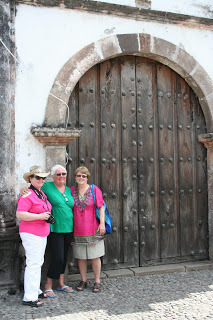 Some of the furniture that Hidalgo designed is on display.It's exquisite. Lovely wood (parota?) with painted inlays, birds and flowers,yellows and oranges and blues. Ornate carvings and interesting designs. We finda book inside a glass case that's signed to Alejandro – a friend of art and afriend of mine in Spanish – from Diego Rivera. He and Freda Kahlo were frequentvisitors and contemporaries of Hildalgo and his wife. Hidalgo donated thebuildings and the grounds to the University of Colima. He died not that manyyears ago.
Some of the furniture that Hidalgo designed is on display.It's exquisite. Lovely wood (parota?) with painted inlays, birds and flowers,yellows and oranges and blues. Ornate carvings and interesting designs. We finda book inside a glass case that's signed to Alejandro – a friend of art and afriend of mine in Spanish – from Diego Rivera. He and Freda Kahlo were frequentvisitors and contemporaries of Hildalgo and his wife. Hidalgo donated thebuildings and the grounds to the University of Colima. He died not that manyyears ago.
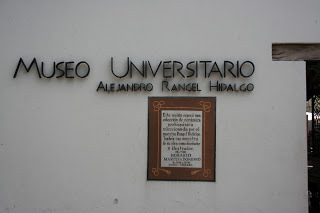 After the museum and studio, we visit the Eco Parque. It'simpossible to recount the number of trees, flowers and bushes that we enjoy,all with the sound of the waterfall and waterways that are constructed on thehillside. The pictures say it best. We sit for a while listening to the wind inthe bamboo making them click and groan, gasping at the beautiful yellowprimavera through green trees and blue sky.
After the museum and studio, we visit the Eco Parque. It'simpossible to recount the number of trees, flowers and bushes that we enjoy,all with the sound of the waterfall and waterways that are constructed on thehillside. The pictures say it best. We sit for a while listening to the wind inthe bamboo making them click and groan, gasping at the beautiful yellowprimavera through green trees and blue sky.
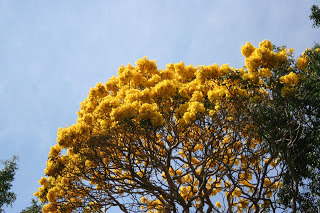
On the way back to Colima, we visit a coffee manufacturingbusiness. It's amazing to see the process and how much is done by hand. Wesample the delicious results. We are much closer to the volcanoes now and snapmore shots. Colima's own Magnetic Hill is next. José stops the van andwe walk it a bit, astounded. By sight, we're going uphill, but it's obviouslydownhill, both because we feel it as we walk and because the car keeps goingeven in neutral. Heading back to the city, I am struck by all the sights:clothes on hangers scattered over a barbed wire fence; plastic dolls in awindow, staring sightlessly through the wrought iron; a bull rests on someone'sfront lawn. A large house has an arch that announces, "Los Simpsons". Chickenspeck in several yards. José shows us a drive-thru beer store. The Sierras glint in the sun and whiteclouds. Sculpted trees and bushes decorate the dancing dogs squareand roadsides. One of them is a human form that looks as though it is sliding,arms raised, down the tree. It reminds me of the poem about sliding to the endof your life calling YIPEE all the way. Appropriately enough, when we return to the hotel, we arejust in time for a seniors' club parade. The dancers are all older and somevery elderly. There are people in wheelchairs. The costumes are astonishing,reds, blues, golds…every color and style imaginable. We dance on the balconiesand drink beer or margueritas. This activity makes for an early dinner and bed!We sleep with the sounds of the church, the people in the square, and trafficjust outside our windows.
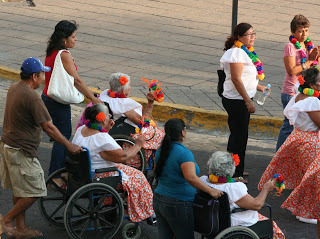
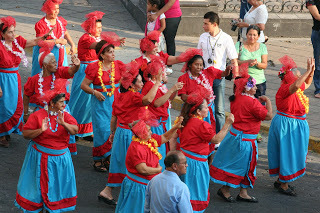
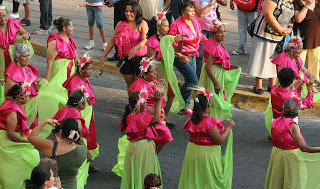
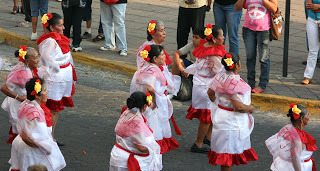
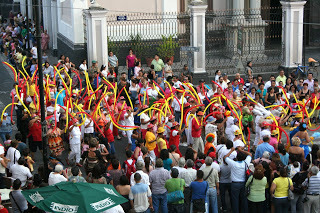
Published on February 24, 2012 06:29
February 23, 2012
February 20, 2012: La Cruz
Mon. Feb. 20: Early in the morning, Manzanillo buzzes withtraffic and people off to work or school. Rosaleen, John and I bump sleepilyalong in the bus, headed for Centro at 7 a.m. Our mission is to climb themountain above the city, where a cross towers over the rooftops, facing ourcondo unit and gleaming at night. When we get into Centro, we walk past the Colonial Hotel andturn right at the Pharmacia Gualadajara. Two short blocks away, we head up thenarrow stairs, some of the steps high, some slanted and small. We are threadingour way through homes built into the sides of the mountain. John has packed for us: water,Gatoraid, and towels for the sweat. Luckily it's a slightly cooler day, the sunhidden a bit by early clouds, a lovely breeze tickling the hills. The houses are like colored blocks piled on top of oneanother, roofs and balconies touching, curving around rock and trees. A watersystem trickles down the pipes at our feet. Each home is not at all fancy. Wecan see into some of them, simple furniture and tiny rooms, babies and mothers,older women, a few men. Fiercely barking dogs are perfect protection. Red,green, white, orange clay brick tiles, wooden, brick and plaster. But the viewthey have from their porches is overwhelming. The sea, the harbour, the hills,the rest of the city laid at their feet. The fool upon the hill…the eyes in his head see the world spinning round... I am breathless and feel as though my heart might explodewhen we finish the stairs. John tells me this is the worst part, a line I'veheard before. We emerge onto a cobble stone roadway and admire the view for awhile. This becomes my mantra for resting when I can't go any further: now, that's a beautiful view. I stare at the narrow rocky paththat we must climb and wonder how I'll do it. Mostly crawling, it turns out. I makemy way up by testing with one foot, grabbing rocks with one hand, leaning forwardto propel my body upward. Very often I pant: now, that's a beautiful view. Slowly, literally hand over fist,we make it up the hillside. Huge cacti, enormous evergreens, palms and bushescover the mountain in green, while colorful flowers fill up the senses with redand white and yellow. Geckoes skirt our clumsy footsteps and clack at us indisapproval. An older man flies by with weights in his hands, passing us on hisway up, passing us in the same direction as he goes back down again. John saysthe man does calisthenics at the cross before heading back, too. I am a littleslower than he is, obviously. I may not do the calisthenics either. When we finally emerge at the top, I experience one of thosesensations that sends goose bumps up and down my arms. The view is spectacular.We get a 350º panorama of the Manzanillo harbour and the Pacific Ocean beyond.We can even see our house from here! (The one in Las Brisas, that is.) I amblown away by the perspective that we get from here, just as everyone who'sbeen up here before me suggested. You can see the mountain ranges and waterwaysthat surround our large inlet. You can follow the ships and watch as they dockin the port. You can see the line of the beach all around Manzanillo Bay. You can see the harbour as it expandsand develops. You can watch the currents flow through the ocean beyond. I'm soglad Rosaleen and John brought their cameras.
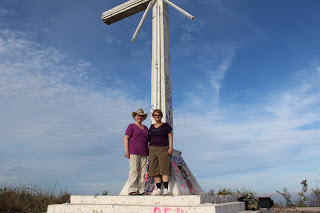
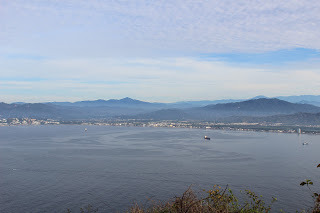
I have a moment where I am so very grateful that I have beenable to experience this. Two years ago, I was far too out of shape to evencontemplate the climb. One year ago, I was too tired, a result of breast cancersurgery and radiation. Here I am, a year beyond that, viewing this gorgeousscenery. I am so very fortunate. We make our way down very slowly, ensuring good footing,careful not to slip on the loose gravel. John goes in front, clearing some ofthe pathway, giving me a shoulder when I need one to lean on to get down asteeper slope. Rosaleen traverses the ground far more steadily and confidently. When we get home, we bring churros for everyone (sweetpastry fried in oil). Vince has made us a fabulous breakfast. Maire declares itthe best meal she's had yet.
Published on February 23, 2012 10:04
February 17, 2012
A Walk in Contrasts
Every morning when Vince and I go for our walk, I am struckby the contrasts. From roadways to lanes, from buildings to homes, our littlesuburb of Manzanillo, Mexico, contains contradictions that seem to dominate thecountry. Industry and commerce versus laid-back attitudes and "manana"philosophy. We walk along stubbly rock-strewn roads to the mainthoroughfare. Cabs, trucks, cars and military vehicles speed by, the latter ontheir way to and from the port. Here the sidewalks display beautiful brickwork, hand laid,designs forming diamonds of grey, red and white. The street itself is brick. Amedium that cuts through the centre is dotted with palms and planters. Red andpink flowers flourish alongside little green, red-tinged bushes and grass. Well-spacedtrees form umbrellas of bean pods and gnarled limbs. As we amble along, we are met by all kinds of people. Youcan see the Spanish heritage in some of the faces, the native influence, thegringo mix. Most of them, Mexican or gringo, nod, smile, and say Buenos Dias.Moms with babies, people off to work, men gathering cans and bottles from thestreets. Businesses are spread out over the sidewalk, leaving the pedestrian totravel through or find a way around. Restaurant owners set up tables or servebreakfast. A hardware store opens its sliding metal doors for customers, amedical clinic, a wide-open church, a laundry, an Internet café. Someone sellscamarones (shrimp) and pesca (fish) out of coolers in front of his house. Tiresare piled next door to a small family restaurant, the oil smells dominatingover the coffee aroma. One of our favourite places to get dinner is an ash pit onthe same lot as a car wash. (Vehicles are water blasted and scrubbed andpolished by hand.) Chicken and ribs are often splayed on poles in the fire pitand we know from experience that they are delicious. Another place we like toeat is what we call the garden restaurant. That's because it's bordered by abeautiful lot of fruit trees and flowers. One building is crumbling, its windows broken and theforlorn interior echoing its grim present. Next door, the plaster is painted abrilliant white. A beautiful young Mexican girl sweeps the sidewalk. Behind thewrought iron gates further on, we can spy a traditional hacienda, done in asoft yellow with dark wooden trim and doors. Bougainvillea grace the decks andbalconies. Palms wave in the breeze and always, there is the sound of thePacific beyond. Construction is booming. A building slowly rises from thesand, its grey concrete bricks with no straight edges propped up by woodenbeams and rebar. Men are spread everywhere, hammering and shaping. At a condosite, two men sit on a platform and place a stunning marble mosaic façadeacross the future balconies. Local hotels, restaurants, offices, and roadwaysare either beautifully improved or in the process. Sometimes these edificeshave been in the process for years, though. Curved orange clay tiles cover many of the rooftops. Littlehotels, pristine restaurants, lovely residences stand next to abandoned lotsstrewn with garbage, broken glass and shredded plaster walls. Another huge lotappears to be empty, until you look back and see a makeshift shed that houses asleek brown horse. Down the street, there's a lot with huge truck cabs gleamingand ready to go. They're here every day, though, so perhaps their transport business is not sogreat. A soft brown Spanish home displays a neat garden of cactus,palms, and flowers. A tiled wading pool sparkles in the sun. One fence istopped with brass statues, all carved into various human shapes and poses. Fromanother doorway, a huge dark skinned woman, her dress tented around herenormous belly and hips, stares out at the sidewalk. A man in a wheelchair sitsinside the courtyard of a small hotel and restaurant. He always waves and callsout Buenos Dias in a deep, hearty voice. Huddled amongst a couple of beautifulhaciendas is a small square house with a dirt floor and muddy yard. Inside, wecan glimpse a bed, a couple of chairs, and several people. They don't seem totalk much. We can walk past rubble, cracked cement, salt-eroded wallsone moment and be surrounded by brown, yellow or brilliant white haciendas thenext. Dog shit and litter mingle with rose petals and palm leaves. The air is usually fresh, with its salty ocean taste, andthe sun (although this year it disappeared for over a week) is normallybrilliant. The plants are lush. The people are friendly. The ocean roars allaround us. Stark contrasts aside, the bottom line is that Las Brisas is vivid,alive and beautiful.
Published on February 17, 2012 09:47
February 13, 2012
Half The Lies We Tell Aren't True
February 11-13, 2012
My father used to have an expression: half the lies I tellaren't true. I think of that as I make my way through the markets here. I hateto haggle. If you've ever seen The Life of Brian, you know what I'm talkingabout. "Aren't goin' to haggle?" is one of Vince's (and, it appears, the sellers') favorite sayings.Everything I buy is rock bottom price, best price, cheaper than K-Mart andbetter than Walmart. Practically free. No commission. Until Vince enters thefray, that is, and suddenly they smile. The former price was not so rock bottomnor practically free. So we have a system. I choose items, he comes in behindme and haggles. I am particularly vulnerable to sellers who have children attheir feet. Those I usually like to bargain upward. Like, isn't that price alittle low? Will you have enough commission to feed your kids? So I have to walk away while Vince does the deed, because Ifeel very guilty. By the way they grin at him yet negotiate with huge sighs andmuch gesturing, they admire him. Obviously half the lies they told about theprice weren't true. The waiter at the Italian restaurant across the street tellsus he's out of this dish and that because of all the people he's served duringthe day. Yet whenever we walk out to catch a bus or visit our favoritebreakfast spot, the seats at his place are empty. Just a little half lie. Afterall, he didn't say what day. Even our manager family gives a bit of the Mexican shufflewhen we ask for things. Our Internet connection troubles have been blamed on "allof Manzanillo". Yet there appears to be service everywhere else around us. Thelikely culprit is their own hardware. We also have boiler problems. They lookat us sympathetically, as though they'd never heard this complaint before.Let's see how long it takes to fix it. There is one beach seller we always look for every year.Until Friday, we hadn't seen him and we were a bit worried. John says he can gohome happy now because he has at last seen Jesus. Seriously, though, Jésus is agood looking Mexican of indeterminate age (literally, since the houses in hishometown somewhere in Guerrera burned down with all his records inside), whosells us necklaces and earrings and talks our heads off. When he speaks slowly,we can understand most of what he says, but then he often forgets himself ashis tale picks up speed and so does his speech pattern. Then he notices ourconfusion and says out loud, como se dice, how can I say this in simpler terms?John always gives him a beer and he stands under the umbrella out of the brutalsun for a time, telling us about his family. He's a grandfather, has a28-year-old, among other children. Maybe he started when he was 14, who knows? The rain is pretty relentless, especially during the night.It sounds as though someone is taking a shower right outside our balcony. Oncewe wake up at 2:30 a.m. to see the wind whipping and the rain in sheets.Luckily we had closed our windows and balcony door. During the rainy day timewe do our shopping for food and other necessities, play dice, watch the wavesroll in and out. The swallows do a square dance on the street side of our unit.We watch them chirping, swarming, diving and dipping in the cloudy sunset. Whenthe weather clears for a bit, we sit on the balcony and watch the birds and thesky. We see a new species (which turns out not to be so new, simply forgottenfrom another year): he's all black except the bottom of the tail and belly,which is a bright yellow. He's a yellow-winged cacique, which Vince already hascircled in his bird book. Grackles gather in the palm above our pool and talk,twee, trill, whistles, high and low, a little giggle here and there. We go outfor hamburgesa y papas fritas y cervesa at Bricio's and watch some futbal withAlex and his wife. Poor Alex has bet on the wrong team! When we come back, one of the swallows has taken a room inour unit: the one outside just above the light fixture in our hallway. The nextmorning, he's on the floor, panting, his little head tucked under his chest.His back feathers are an exquisite blue, which we hadn't noticed before. Hisorange belly is hidden as he breathes in gasps. He must have hit a wall tryingto exit quickly. We leave him alone for a while, then gently move him to theledge and some fresh air, so no one will step on him. We don't have much hope.But I am reminded of a poem I wrote about a very similar situation, a long timeago.birdagainst the windowlies bent in the leaveswe sit and watchthe sun warm on our fingersentwined on the tableit will be all right he tells mebut I don't believehis eyes catch mine and hold themhis love surges inside mehis faith warms meI feel myself let goreach out to trust himthe bird fluffs his wingsflies away in the sun And he does. I am going down the steps when I see him. Hislittle orange and blue body revived, he spreads his wings and heads for theother swallows lining the wires around our unit. I take it as a good omen. The sky clears later, so we head for the Miramar market.Suddenly it's hot again and humid. We shop, then have lunch gazing out at thegorgeous flat beach of Santiago Bay with its folding frolicking waves. On ourreturn (in an air conditioned cab!), we gather back on our own beach, wet sandbaking in the welcome sun under our feet. Sunday kids are playing in the waterand throwing sand at each other on the beach. Their dogs roll and scuffle underour chairs, leave a deposit by the steps. Schools of silver fish have arrived.They are boiling the water again, but this time we can hear them, the ocean isso calm. They sound like water babbling over stones in a stream as they skimalong the surface, over and under one another, as though they are racing awayfrom something bigger underneath. And maybe they are. From above, the birds gather. Pelicans skim the surface, orland in the middle of the broil of fish, fluttering back up with a flash ofsilver in their beaks. The magnificent frigates and cormorants are kamikazes asthey go beak-first into the sea, disappear for a moment, and come straight backup with lunch. We are enjoying our Mexican TV when the sand rumbles underour feet. As though a giant serpent is burrowing its way underground, like thatold Kevin Bacon movie. The earth has moved. Later, we settle to watch thespectacular sunset on our balconies, and it moves again. The balcony shakes asthough someone massively strong is running through the hallway. Earthquake. Thekind of sigh from the ground that my son and daughter-in-law feel all the timein LA. For me and Vince, it's a new sensation to know that you are not reallyin control. Mother Nature is. And it's not nice to fool Mother Nature. We have no idea why, but our Skype and our Internet won'tconnect later on, even though the signal looks strong. We are horriblydisappointed, as we were supposed to see Dave, Rebecca, Sydney and Evan. On topof that, I look at my quarterly statements from my publisher. As a result ofboth disappointments, I go to bed in a huge snit, deciding never to write norleave my house ever ever again. So there. Probably another lie that's not true.

My father used to have an expression: half the lies I tellaren't true. I think of that as I make my way through the markets here. I hateto haggle. If you've ever seen The Life of Brian, you know what I'm talkingabout. "Aren't goin' to haggle?" is one of Vince's (and, it appears, the sellers') favorite sayings.Everything I buy is rock bottom price, best price, cheaper than K-Mart andbetter than Walmart. Practically free. No commission. Until Vince enters thefray, that is, and suddenly they smile. The former price was not so rock bottomnor practically free. So we have a system. I choose items, he comes in behindme and haggles. I am particularly vulnerable to sellers who have children attheir feet. Those I usually like to bargain upward. Like, isn't that price alittle low? Will you have enough commission to feed your kids? So I have to walk away while Vince does the deed, because Ifeel very guilty. By the way they grin at him yet negotiate with huge sighs andmuch gesturing, they admire him. Obviously half the lies they told about theprice weren't true. The waiter at the Italian restaurant across the street tellsus he's out of this dish and that because of all the people he's served duringthe day. Yet whenever we walk out to catch a bus or visit our favoritebreakfast spot, the seats at his place are empty. Just a little half lie. Afterall, he didn't say what day. Even our manager family gives a bit of the Mexican shufflewhen we ask for things. Our Internet connection troubles have been blamed on "allof Manzanillo". Yet there appears to be service everywhere else around us. Thelikely culprit is their own hardware. We also have boiler problems. They lookat us sympathetically, as though they'd never heard this complaint before.Let's see how long it takes to fix it. There is one beach seller we always look for every year.Until Friday, we hadn't seen him and we were a bit worried. John says he can gohome happy now because he has at last seen Jesus. Seriously, though, Jésus is agood looking Mexican of indeterminate age (literally, since the houses in hishometown somewhere in Guerrera burned down with all his records inside), whosells us necklaces and earrings and talks our heads off. When he speaks slowly,we can understand most of what he says, but then he often forgets himself ashis tale picks up speed and so does his speech pattern. Then he notices ourconfusion and says out loud, como se dice, how can I say this in simpler terms?John always gives him a beer and he stands under the umbrella out of the brutalsun for a time, telling us about his family. He's a grandfather, has a28-year-old, among other children. Maybe he started when he was 14, who knows? The rain is pretty relentless, especially during the night.It sounds as though someone is taking a shower right outside our balcony. Oncewe wake up at 2:30 a.m. to see the wind whipping and the rain in sheets.Luckily we had closed our windows and balcony door. During the rainy day timewe do our shopping for food and other necessities, play dice, watch the wavesroll in and out. The swallows do a square dance on the street side of our unit.We watch them chirping, swarming, diving and dipping in the cloudy sunset. Whenthe weather clears for a bit, we sit on the balcony and watch the birds and thesky. We see a new species (which turns out not to be so new, simply forgottenfrom another year): he's all black except the bottom of the tail and belly,which is a bright yellow. He's a yellow-winged cacique, which Vince already hascircled in his bird book. Grackles gather in the palm above our pool and talk,twee, trill, whistles, high and low, a little giggle here and there. We go outfor hamburgesa y papas fritas y cervesa at Bricio's and watch some futbal withAlex and his wife. Poor Alex has bet on the wrong team! When we come back, one of the swallows has taken a room inour unit: the one outside just above the light fixture in our hallway. The nextmorning, he's on the floor, panting, his little head tucked under his chest.His back feathers are an exquisite blue, which we hadn't noticed before. Hisorange belly is hidden as he breathes in gasps. He must have hit a wall tryingto exit quickly. We leave him alone for a while, then gently move him to theledge and some fresh air, so no one will step on him. We don't have much hope.But I am reminded of a poem I wrote about a very similar situation, a long timeago.birdagainst the windowlies bent in the leaveswe sit and watchthe sun warm on our fingersentwined on the tableit will be all right he tells mebut I don't believehis eyes catch mine and hold themhis love surges inside mehis faith warms meI feel myself let goreach out to trust himthe bird fluffs his wingsflies away in the sun And he does. I am going down the steps when I see him. Hislittle orange and blue body revived, he spreads his wings and heads for theother swallows lining the wires around our unit. I take it as a good omen. The sky clears later, so we head for the Miramar market.Suddenly it's hot again and humid. We shop, then have lunch gazing out at thegorgeous flat beach of Santiago Bay with its folding frolicking waves. On ourreturn (in an air conditioned cab!), we gather back on our own beach, wet sandbaking in the welcome sun under our feet. Sunday kids are playing in the waterand throwing sand at each other on the beach. Their dogs roll and scuffle underour chairs, leave a deposit by the steps. Schools of silver fish have arrived.They are boiling the water again, but this time we can hear them, the ocean isso calm. They sound like water babbling over stones in a stream as they skimalong the surface, over and under one another, as though they are racing awayfrom something bigger underneath. And maybe they are. From above, the birds gather. Pelicans skim the surface, orland in the middle of the broil of fish, fluttering back up with a flash ofsilver in their beaks. The magnificent frigates and cormorants are kamikazes asthey go beak-first into the sea, disappear for a moment, and come straight backup with lunch. We are enjoying our Mexican TV when the sand rumbles underour feet. As though a giant serpent is burrowing its way underground, like thatold Kevin Bacon movie. The earth has moved. Later, we settle to watch thespectacular sunset on our balconies, and it moves again. The balcony shakes asthough someone massively strong is running through the hallway. Earthquake. Thekind of sigh from the ground that my son and daughter-in-law feel all the timein LA. For me and Vince, it's a new sensation to know that you are not reallyin control. Mother Nature is. And it's not nice to fool Mother Nature. We have no idea why, but our Skype and our Internet won'tconnect later on, even though the signal looks strong. We are horriblydisappointed, as we were supposed to see Dave, Rebecca, Sydney and Evan. On topof that, I look at my quarterly statements from my publisher. As a result ofboth disappointments, I go to bed in a huge snit, deciding never to write norleave my house ever ever again. So there. Probably another lie that's not true.
Published on February 13, 2012 06:14



